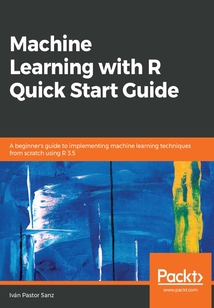舉報 

會員
Machine Learning with R Quick Start Guide
MachineLearningwithRQuickStartGuidetakesyouonadata-drivenjourneythatstartswiththeverybasicsofRandmachinelearning.Itgraduallybuildsuponcoreconceptssoyoucanhandlethevariedcomplexitiesofdataandunderstandeachstageofthemachinelearningpipeline.FromdatacollectiontoimplementingNaturalLanguageProcessing(NLP),thisbookcoversitall.Youwillimplementkeymachinelearningalgorithmstounderstandhowtheyareusedtobuildsmartmodels.Youwillcovertaskssuchasclustering,logisticregressions,randomforests,supportvectormachines,andmore.Furthermore,youwillalsolookatmoreadvancedaspectssuchastrainingneuralnetworksandtopicmodeling.Bytheendofthebook,youwillbeabletoapplytheconceptsofmachinelearning,dealwithdata-relatedproblems,andsolvethemusingthepowerfulyetsimplelanguagethatisR.
目錄(148章)
倒序
- coverpage
- Title Page
- Copyright and Credits
- Machine Learning with R Quick Start Guide
- About Packt
- Why subscribe?
- Packt.com
- Contributors
- About the author
- About the reviewer
- Packt is searching for authors like you
- Preface
- Who this book is for
- What this book covers
- To get the most out of this book
- Download the example code files
- Download the color images
- Conventions used
- Get in touch
- Reviews
- R Fundamentals for Machine Learning
- R and RStudio installation
- Things to know about R
- Using RStudio
- RStudio installation
- Some basic commands
- Objects special cases and basic operators in R
- Working with objects
- Working with vectors
- Vector indexing
- Functions on vectors
- Factor
- Factor levels
- Strings
- String functions
- Matrices
- Representing matrices
- Creating matrices
- Accessing elements in a matrix
- Matrix functions
- Lists
- Creating lists
- Accessing components and elements in a list
- Data frames
- Accessing elements in data frames
- Functions of data frames
- Importing or exporting data
- Working with functions
- Controlling code flow
- All about R packages
- Installing packages
- Necessary packages
- Taking further steps
- Background on the financial crisis
- Summary
- Predicting Failures of Banks - Data Collection
- Collecting financial data
- Why FDIC?
- Listing files
- Finding files
- Combining results
- Removing tables
- Knowing your observations
- Handling duplications
- Operating our problem
- Collecting the target variable
- Structuring data
- Summary
- Predicting Failures of Banks - Descriptive Analysis
- Data overview
- Getting acquainted with our variables
- Finding missing values for a variable
- Converting the format of the variables
- Sampling
- Partitioning samples
- Checking samples
- Implementing descriptive analysis
- Dealing with outliers
- The winsorization process
- Implementing winsorization
- Distinguishing single valued variables
- Treating missing information
- Analyzing the missing value
- Understanding the results
- Summary
- Predicting Failures of Banks - Univariate Analysis
- Feature selection algorithm
- Feature selection classes
- Filter methods
- Wrapper methods
- Boruta package
- Embedded methods
- Ridge regression
- A limitation of Ridge regression
- Lasso
- Limitations of Lasso
- Elastic net
- Drawbacks of elastic net
- Dimensionality reduction
- Dimensionality reduction technique
- Summary
- Predicting Failures of Banks - Multivariate Analysis
- Logistic regression
- Regularized methods
- Testing a random forest model
- Gradient boosting
- Deep learning in neural networks
- Designing a neural network
- Training a neural network
- Support vector machines
- Selecting SVM parameters
- The SVM kernel parameter
- The cost parameter
- Gamma parameter
- Training an SVM model
- Ensembles
- Average model
- Majority vote
- Model of models
- Automatic machine learning
- Standardizing variables
- Summary
- Visualizing Economic Problems in the European Union
- A general overview of economic problems in countries
- Understanding credit ratings
- The role of credit rating agencies
- The credit rating process
- Clustering countries based on macroeconomic imbalances
- Data collection
- Downloading and viewing the data
- Streamlining data
- Studying the data
- Acquiring the target variable
- Acquiring the credit quality
- Displaying the credit ratings on a map
- Carrying out a descriptive analysis of data
- Detecting macroeconomic imbalances
- The self-organizing maps technique
- Training the SOM
- Summary
- Sovereign Crisis - NLP and Topic Modeling
- Predicting country ratings using macroeconomic information
- Implementing decision trees
- Ordered logistic regression
- Predicting sovereign ratings using European country reports
- Summary
- Other Books You May Enjoy
- Leave a review - let other readers know what you think 更新時間:2021-06-24 16:01:50
推薦閱讀
- 工業機器人虛擬仿真實例教程:KUKA.Sim Pro(全彩版)
- 大數據戰爭:人工智能時代不能不說的事
- 構建高質量的C#代碼
- 基于LabWindows/CVI的虛擬儀器設計與應用
- 控制與決策系統仿真
- Learning Apache Cassandra(Second Edition)
- 人工智能工程化:應用落地與中臺構建
- Hands-On Cybersecurity with Blockchain
- Associations and Correlations
- WordPress Theme Development Beginner's Guide(Third Edition)
- RPA(機器人流程自動化)快速入門:基于Blue Prism
- 觸控顯示技術
- 網絡安全與防護
- Silverlight 2完美征程
- 工業機器人入門實用教程
- Hands-On Deep Learning with Go
- Serverless Design Patterns and Best Practices
- 案例解說虛擬儀器典型控制應用
- 傳感器原理及應用(第二版)
- 仿蛛機器人的設計與制作
- 大數據挖掘與統計機器學習
- 網絡攻防工具
- Learning PostgreSQL 10(Second Edition)
- ARM Cortex-M3微控制器原理與應用
- 自動化生產線裝配與調試技術-:基于西門子S7-200系列PLC
- 工業控制系統及應用:SCADA系統篇(第2版)
- Hands-On Data Science with R
- Hands-On Q-Learning with Python
- iOS軟件開發兵法
- Practical OneOps

